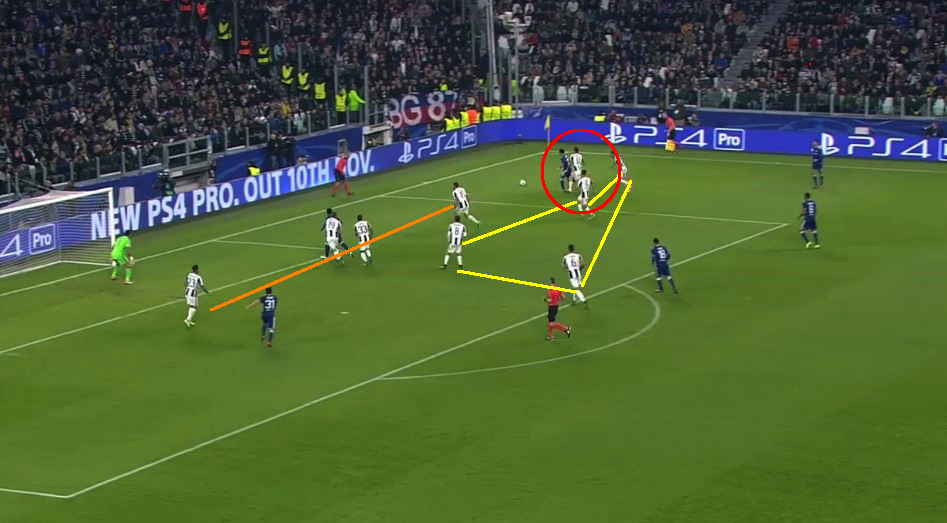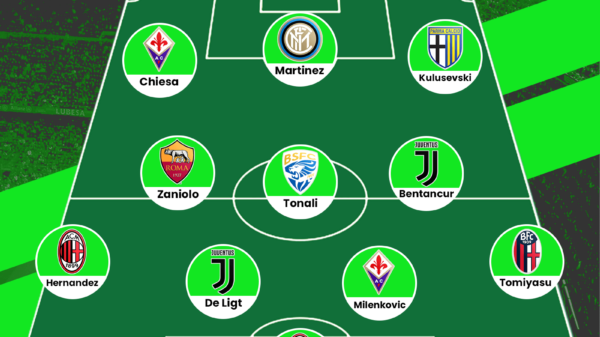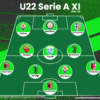Eric Devin writes a detailed tactical analysis of the UEFA Champions League match that ended Juventus 1-1 Lyon.
Lyon came to the Juventus Stadium on Wednesday evening with their backs against the wall. They had played a decent match against the Italian side at home on Matchday Three, only to be stunned by Juan Cuadrado’s rasping winner. Gianluigi Buffon was the real hero of the match, though, and while Juventus did ride their luck at times a fortnight ago, this time around, manager Massimiliano Allegri seemed to have absorbed a lesson or two from the previous encounter. Having to settle for a draw was no doubt disappointing for the hosts, but facing a must-win match against Sevilla, the Bianconeri should take pride in the success of their adjustments.
Juventus (4-4-2 diamond): Gianluigi Buffon; Dani Alves, Leonardo Bonucci (Medhi Benatia 68′), Andrea Barzagli, Patrice Evra; Claudio Marchisio; Sami Khedira, Stefano Sturaro; Miralem Pjanic (Alex Sandro 68′); Mario Mandzukic, Gonzalo Higuaín (Juan Cuadrado 83′)
Olympique Lyonnais (4-4-2 double six): Anthony Lopes; Rafael da Silva, Emanuel Mammana, Mouctar Diakhaby, Jérémy Morel; Maxime Gonalons, Corentin Tolisso; Rachid Ghezzal, Maciej Rybus (Maxwell Cornet 70′); Nabil Fekir (Sergi Darder 77′), Alexandre Lacazette
The biggest change for Juventus was their initial shape. The team is mostly associated with playing 3-5-2, a tactic first developed by Antonio Conte to get the best out of his three central defenders, Andrea Barzagli, Leonardo Bonucci and Giorgio Chiellini. Juventus do still employ that system, as they had against Lyon at the Parc OL, but under Allegri, the team have hardly been averse to adding the odd wrinkle, and on this occasion, it was a move to a diamond 4-4-2.
Lyon would be forced to come at them, needing a result, and so Allegri opted for this formation, knowing it would give his side their best look creatively in the absence of the injured Paulo Dybala. Dybala’s energy and movement had been key to stretching Lyon’s back three in the last match, but without him, Mandzukic would partner Higuaín up top, making for a rather static strike partnership.
Miralem Pjanic was used as the attacking midfielder, while Khedira retained his place on the right of midfield. Opposite the German was Sturaro, a more prosaic option than either Hernanes or Alex Sandro, but one who could give the hosts the solidity they would need. At the base of the diamond was Claudio Marchisio, who had only played 100 minutes of football ahead of the match, returning as he was from a long-term knee injury. It was somewhat surprising to see Allegri turn to the veteran given an inevitable degree of rust, but the mobile pair of Alves and Evra at fullbacks would seek to provide support in this regard.
In the above image, we can see the formation working to a tee. Juventus are playing very narrow, forcing Lyon into an area less than half the width of the pitch. Marchisio marshals Fekir, while Evra comes wide to mark Lopes’ delivery to Ghezzal. The Lyon ‘keeper is one of France’s best, but his distribution, an issue in the last match, was still problematic, and Juventus’ compact approach was effective here, as Lacazette was able to be double-marked by Barzagli and Bonucci.
Lyon also trotted out a different formation on the evening, opting to play a 4-4-2 “double six”, with Tolisso and Gonalons in front of the defense. The formation had shown some promise in a win over Toulouse at the weekend, and it did allow Bruno Genesio to put a maximum of attacking players on the pitch, with Tolisso joining the front four when possible. One has to laud Genesio’s bravery here, but also take issue with how it eventually limited Tolisso.
The French U-21 international can be a wonderful asset when given license to get forward, but in this formation, he is tasked with a higher defensive workload than in a 4-3-3 or 3-5-2, as his committing more fully to a given attack has the knock-on effect of leaving Gonalons exposed. Gonalons is, to his credit, a decent holding midfielder, but with the youthful partnership of Diakhaby and Mammana behind him, Tolisso generally thought it wise to keep close to the captain.
This left Rybus and Ghezzal to stretch play, and the two gave a game effort, even if their running tended to be more vertical than horizontal, which made Juventus’ task of narrowing the pitch easier. Rybus makes sense in a more advanced role here; he is a more orthodox winger than Cornet, who replaced him, even if he is less of a goal threat, but he, like Ghezzal on the opposite flank, failed to free much space for the two strikers. It should be mentioned here that Fekir and Lacazette were playing as more of a strike partnership than usual. The two occupied very similar areas, and with Morel and Rafael loath to get forward from fullback, were often isolated and marked out of the match. Had one or both been more willing to drop for the ball and run at Juventus’ defense, they might’ve had more joy going forward, but as it was, the pair defined frustration on the night.
There was some hope, though, that with more players committed to forward areas, Lyon could improve the intensity of their press, which was poor on the last occasion. Neither Ghezzal not Rybus is well-known for harrying opposing back lines, but they and the two strikers made a go of it, as this sequence shows. In the first, as Barzagli tries to play the ball upfield, Fekir rushes to close him down, while Lacazette cuts down the angle to Bonucci, who would be the ideal option to start a counterattack, given his range of passing. Ghezzal, at the bottom, keeps close to Evra, while Gonalons anticipates a through ball to Marchisio.
In the second image, Fekir has overrun Barzagli, who is about to deliver a pass, but still remains under pressure, with Evra having moved much closer to provide an outlet. Gonalons, in advanced position, seeks to deny the ball to Marchisio, while Lacazette continues to anticipate a pass to Bonucci. This kind of pressure was excellent to see from a Lyon side who have, despite the obvious talents they have in attack, are sometimes lacking in this phase of the game, especially against teams whose fullbacks have a good range of passing.
It was an encouraging start, but by the beginning of the second half, Lyon had reverted to type, their intensity dramatically dropped. Here, Bonucci has the ball at his feet, but instead of the earlier pressure we had seen on Barzagli, the younger center back is in acres of space (blue arc) and in a more advanced position on the pitch. The five red lines indicate potential passing options; he can play a short pass to one of Alves or Barzagli, a medium pass to Evra, or a long ball to one of Pjanic or Sturaro (red lines).
There is an element of risk to all of those options, to be sure, but compared to the paucity of choice that Barzagli had in the earlier sequence, this would have seemed to be unfolding in slow motion for Bonucci. Even if Juventus failed to fashion much in the way of quality chances as a result, it still allowed them to control the tempo of the match, an important factor for an aged defense and a defensive midfielder just back from a major spell of inaction.
That said, even if Lyon weren’t doing their best to harry the hosts, they were still intent on getting numbers forward, especially after Juventus had gone ahead. Here, early in the second half, we see Lyon having pushed very high up the pitch. Lacazette is receiving the ball with his back to goal, looking Tolisso and Fekir (yellow circles) to facilitate play creatively. Ghezzal and Rybus are even further forward than the two strikers, and their potential runs (red lines) give Tolisso and Fekir the option of not only shooting or linking play along the ground but also attempting to play a ball over the top. Note, too, that Diakhaby and Gonalons are also occupying advanced positions, providing an opportunity for the more creative players to reset the attack if an opportunity isn’t forthcoming. Thus, despite failing to consistently but pressure on the hosts, Lyon were still able to maintain enough in sheer numbers in attack to limit Juventus.
It wasn’t as though Allegri hadn’t anticipated this, though, and in the first image, we can see the apotheosis of that. The back four (orange line) occupy a narrow zone, with Alves monitoring Rybus on the near side and Evra and Bonucci double-marking Lacazette centrally. Barzagli has moved across to close down Rafael (red circle), who is attempting to turn the corner against the midfield. Now, Rafael is certainly a decent attacking full-back, but with one player on him and another seeking to block his cross, and his target double-marked, it would have to take something special for him to fashion any sort of opportunity.
At the edge of the area, the members at midfield diamond, indicated by the yellow lines, now sit in an almost absurdly compact situation. Marchisio is in a free role, while Khedira tracks a potential run by Fekir. Pjanic and Sturaro have shifted over to help close down Rafael, the Brazilian thus being effectively triple-teamed. I say triple-teamed, because with Evra minding Lacazette centrally, the player defending the right back’s run most closely is actually Mandzukic, who despite his reputation as a brawny target man, was actually instrumental in covering the runs of Lyon’s fullbacks, something which couldn’t be readily said of his French counterparts.
Indeed, as this image shows, he even went beyond merely tracking runs to actually setting up as member of midfield when Lyon were in possession. The red lines indicate Juventus deploying not as a diamond but as a rough 4-1-4-1. Marchisio can shift between defense and midfield as needed, and on the right, Khedira shifts wide with Pjanic dropping between he and the Italian. On the left, Mandzukic has moved wide, with Sturaro guarding against Ghezzal’s proclivity for cutting inside. Even as Rafael seeks to run outside Ghezzal and off the flank (white line) onto a reverse ball, Evra, free at the edge of the defense, has plenty of time to move to close him down.
The missing figure in the 4-1-4-1, then is Higuaín, and even though the Argentine didn’t figure prominently in Juventus’ defensive set-up, he, too was a diligent worker on the evening. Here, he has dropped deep into midfield to receive the ball. The result leaves Lyon’s propensity for playing narrowly badly exposed. The two yellow slashes mark the width of Les Gones’ back four, with Rafael just out of the frame as Diakhaby seeks to get back to his place. Ahead of the defense, Lyon has continued to cede the flanks to Juventus, as the double pivot has now been replaced by a diamond, with Tolisso and Gonalons at its tips.
With Higuaín on the ball, Ghezzal and Rybus form the other corners of the diamond, tracking the runs of Khedira and Sturaro. Juventus admittedly did find space hard to come by centrally in this manner, but that was hardly a problem on the flanks. We can see Alves and Evra getting a bit further forward as well, and each has a wealth of green grass ahead of them, as indicated by the red arrows. It is all too easy here for Higuaín to switch play to one of the pair and race into the box for a return, with Mandzukic a target as well. On the whole, Evra and Alves weren’t as successful delivering the ball from wide areas as Sandro and Alves had been in the prior match, but this example still remains a good illustration of how being willing to put a shift in can make it much easier to create space for your teammates, even without being the most fleet of foot.
As the match wore on, though, Juventus sat deeper and deeper, readily absorbing Lyon’s attacks, as these two images show. As previously mentioned, Allegri has experimented with a number of systems, but still favors the 3-5-2 in high pressure situations, something which much of the second half certainly was. Juventus had failed to build on their early lead, and Lyon had started to ramp up the pressure, and we saw the team start to shift to a three man defense early in the second half as a means of coping.
In the left image, Marchisio has slipped between the two central defenders to form a back three. The formation isn’t yet the 3-5-2 that we see in the image at right, after the introduction of Sandro and Benatia, but it does show a more cautious approach from the Bianconeri, as Allegri sought to lighten the workload of Marchisio, who could seem less than match fit at times, while also continuing to stretch play horizontally (note the wide positions of Alves and Evra). It did mean being outnumbered in midfield, as Lyon played more of a flat four in the second half, but the tireless Sturaro ensured the numerical deficit had little bearing on the outcome, with Lyon’s equalizer coming from a free kick.
As a coda, it is hard to comprehend Lyon’s actions after getting a late equalizer through Tolisso. As this final image shows, what had been a neat double pivot or flat 4-4-2 has dissolved into chaos in the match’s waning minutes. Sergi Darder has come on for Nabil Fekir, and the young Spaniard is part of a relatively flat midfield, with Ghezzal outside him. Centrally, Maxwel Cornet, another substitute has taken up the central role of Fekir, but in doing so, he has left Tolisso’s left undefended against the potential run of Alves, indicated by the red line. Again, the three fullbacks all had underwhelming matches in this regard, but had their crossing been better, Juventus would have had a field day.
Thus, while Lyon had shown signs of improvement by playing a more wholly attacking lineup and formation, their lack of focus on the pressing aspect of their play caused their overall performance to suffer. They played too narrowly in all phases of the game, and while a draw at Juventus is hardly a poor result, Lyon now face long odds as regards their progression. Juventus will rue their set-piece marking, but tactically, Allegri got it right, his tactics aided by a stellar effort from his strike duo. A bit of irony for a pair not particularly regarded as being fleet of foot, but a result which is largely to their credit.
Read all our other tactical analyses here.






































































